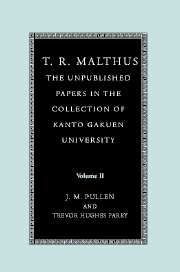Book contents
- Frontmatter
- Contents
- Preface
- Editorial procedures
- List of abbreviations
- Acknowledgements
- 1 Sermons
- 2 Malthus' diary of a tour of the Lake District
- 3 Bullion trade transactions
- 4 An essay on foreign trade
- 5 Essays and notes on Charles I and Mary, Queen of Scots
- 6 Questions and answers on early European history
- 7 Harriet Malthus' diary of a family tour of Scotland in 1826
- 8 Letters to Harriet Malthus from her mother, Catherine Eckersall
- 9 Eight brief miscellaneous items
- Appendix A Additional material not reproduced
- Appendix B Letters to David Ricardo
- Bibliography
- Kanto Gakuen Catalogue
- Index
3 - Bullion trade transactions
Published online by Cambridge University Press: 23 December 2009
- Frontmatter
- Contents
- Preface
- Editorial procedures
- List of abbreviations
- Acknowledgements
- 1 Sermons
- 2 Malthus' diary of a tour of the Lake District
- 3 Bullion trade transactions
- 4 An essay on foreign trade
- 5 Essays and notes on Charles I and Mary, Queen of Scots
- 6 Questions and answers on early European history
- 7 Harriet Malthus' diary of a family tour of Scotland in 1826
- 8 Letters to Harriet Malthus from her mother, Catherine Eckersall
- 9 Eight brief miscellaneous items
- Appendix A Additional material not reproduced
- Appendix B Letters to David Ricardo
- Bibliography
- Kanto Gakuen Catalogue
- Index
Summary
INTRODUCTION
These 40 pages of manuscript are concerned with the trade in bullion between London and other European centres – in particular, with Amsterdam and Hamburg. Their main aim appears to have been to show under what conditions (of prices and exchange rates) profits could be made by buying gold or silver in one centre and selling it in another. They include not only general instructions on how to calculate profits in the bullion trade, but also many calculations using hypothetical or historical data.
It is not known whether Malthus prepared these notes out of academic interest or with a view to engaging in the bullion trade. His academic interest in the bullion trade is evident in the following question that he set in an examination paper at the East India College in 1808 – ‘What are the causes which tend to raise the Market Price of Bullion above the Mint Price?’ An academic interest in commercial matters is also implied by the terms of his appointment to the East India College. Although his title was later changed to ‘Professor of History and Political Economy’, his letter of acceptance of 10 July 1805 shows that he was initially appointed to the ‘Professorship of General History, Politics, Commerce and Finance’.
- Type
- Chapter
- Information
- Publisher: Cambridge University PressPrint publication year: 2004



